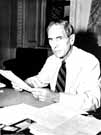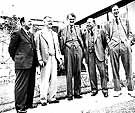
|
|
|

|

|

|

|
|
Click on an image to see a larger, more detailed picture.
|
|
|
|
|
| 1943: Death and Resistance |

|
pg. 442 |

|
|
|
|
| |
 Assistant Secretary of State Breckinridge Long exercised his influence within the State Department to prevent the U.S. from becoming a place of refuge for European Jews. Long's xenophobia influenced practically every move he made during the war: He led the State Department action to deny visas to political and intellectual refugees. He pushed for decreased immigration quotas. And he suggested Bermuda as the site for the refugee conference because of its inaccessibility.
Assistant Secretary of State Breckinridge Long exercised his influence within the State Department to prevent the U.S. from becoming a place of refuge for European Jews. Long's xenophobia influenced practically every move he made during the war: He led the State Department action to deny visas to political and intellectual refugees. He pushed for decreased immigration quotas. And he suggested Bermuda as the site for the refugee conference because of its inaccessibility.
Photo: National Archives / United States Holocaust Memorial Museum Photo Archive
|
 Individuals from a range of professional backgrounds attended the ill-fated Bermuda Conference on refugees in April 1943. Standing (from left to right) are George Hall, the British parliamentary undersecretary in the Admiralty; Harold W. Dodds, president of Princeton University; Richard K. Law, British undersecretary for foreign affairs; Sol Bloom, chairman of the United States House Foreign Affairs Committee; and Osbert Peake, parliamentary undersecretary in the home office.
Individuals from a range of professional backgrounds attended the ill-fated Bermuda Conference on refugees in April 1943. Standing (from left to right) are George Hall, the British parliamentary undersecretary in the Admiralty; Harold W. Dodds, president of Princeton University; Richard K. Law, British undersecretary for foreign affairs; Sol Bloom, chairman of the United States House Foreign Affairs Committee; and Osbert Peake, parliamentary undersecretary in the home office.
Photo: AP / Wide World
|
|
The Bermuda Conference Public outcry in the United States and Britain over the news that the Nazi regime was systematically murdering European Jewry provided the impetus for the Bermuda Conference of April 1943. Although ostensibly designed to solve the refugee problem caused by Hitler's genocidal policies, the conference is regarded as the pinnacle of Allied efforts to stonewall rescue operations. Pre-conference negotiations limited the topics open to discussion in Bermuda, which virtually guaranteed the conference's failure. British and American officials decided beforehand to downplay the Jewish part of the problem and insist that Jews were only one of many victimized groups during the war. The decision demonstrated the unwillingness of Britain and the U.S. to seriously consider plans to rescue European Jews from the clutches of the Nazi regime. A myriad of additional problems doomed the entire enterprise. Designed to deflect an aroused public opinion, the Bermuda Conference failed completely. In the words of Myron C. Taylor, the principal American representative at the Evian Conference of 1938, "The Bermuda Conference was wholly ineffective...and we knew it would be." The British and American governments' indifference to the tragic plight of European Jewry was plain for all to see.
|
|

|

|

|

|
 April 5, 1943: At the Treblinka death camp station, the final train bringing Jews from Macedonia arrives. All aboard are gassed immediately.
April 5, 1943: At the Treblinka death camp station, the final train bringing Jews from Macedonia arrives. All aboard are gassed immediately.
|
 April 7, 1943: Jewish resistance led by Michael Glanz occurs at Skalat, Ukraine.
April 7, 1943: Jewish resistance led by Michael Glanz occurs at Skalat, Ukraine.
|
 April 8-9, 1943: One thousand Jews are executed near Ternopol, Ukraine.
April 8-9, 1943: One thousand Jews are executed near Ternopol, Ukraine.
|
 April 13, 1943: In the Katyn Forest in the Soviet Union, the Germans discover more than 4000 corpses of Polish officers, some of them Jews. The officers were killed by the Soviets.
April 13, 1943: In the Katyn Forest in the Soviet Union, the Germans discover more than 4000 corpses of Polish officers, some of them Jews. The officers were killed by the Soviets.
|
|
|
|
|
| 1943: Death and Resistance |

|
pg. 442 |

|
|
The Holocaust Chronicle
© 2009 Publications International, Ltd.
|
|
